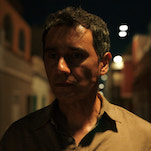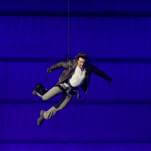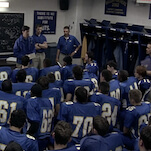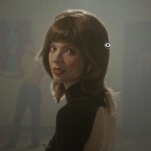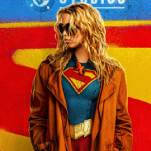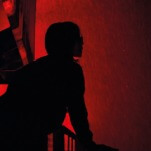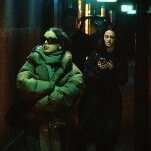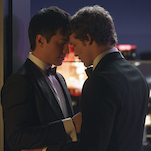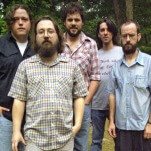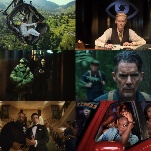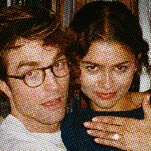The New Cult Canon: Songs From The Second Floor
"There an old joke: Two elderly women are at a
Catskills mountain resort, and one of them says, 'Boy, the food at this place
is really terrible.' The other says, 'Yeah, I know, and such small portions.'
Well, that's essentially how I feel about life—full of loneliness, and
misery, and suffering, and unhappiness, and it's all over much too
quickly." —Woody Allen, Annie Hall
It's a fitting coincidence that I find myself
writing about Roy Andersson's mordant black comedy Songs From The Second
Floor as
the global economy, torpedoed by a vast Ponzi scheme involving subprime
mortgages, stands on the verge of total collapse. Back in 2000, when
Andersson's film shared the Special Jury Prize at Cannes, there was no shortage
of apocalyptic visions—nuclear, natural, zombified—that stirred the
pot of Y2K millennial anxiety. It wasn't a matter of whether society would crumble at
our feet, so much as how, and Songs From The Second Floor connects humanity's
downfall to economics, frequently recalling the bureaucratic nightmare of Terry
Gilliam's Brazil.
In Andersson's world, capitalism has exacted a spiritual price: As his legions
of pallid businessmen shuffle off this mortal coil, they do so in tailored
three-piece suits.
Before I go any further, here are a few fun facts
about Songs From The Second Floor:
— The
film consists of 46 scenes, all rendered in static tableaux (the camera moves
once), and it took about four years to produce.
— None of the scenes were scripted or
storyboarded. They were constructed under Andersson's direction, on two giant
soundstages, with non-professional actors.
— Some
scenes took as much as five weeks to set up and required as many as 100 takes. If
Andersson wasn't happy with the end result, he'd order the set destroyed and
start again.
— The
price tag for the movie was $5.5 million, over five times its original budget,
and a portion of that came out of Andersson's pocket. (He was famous for
commercials that no less a source than his Swedish countryman Ingmar Bergman
called the best in the world.)
The first striking thing about Songs From The
Second Floor,
well before its grim themes take shape, is its astonishing style, which has
drawn comparisons to everyone from Bergman to Terry Gilliam to Jacques Tati to
Stanley Kubrick. Andersson's stationary camera captures whole scenes in long
master shots, but his frames are extraordinarily layered and dynamic, with
action in the foreground and background, and a depth of field that seems to
stretch to infinity. (One of the problems of reviewing it on DVD is that the
format can only hint at its visual impact, especially toward the end of the
film, when Andersson widens his scope from individual strife to the teeming,
miserable mass of humanity.) The 46 tableaux have an undeniably painterly
quality: One shot, set in a diner, looks like Edward Hopper's "Nighthawks" from
a reverse perspective, with the camera peering out from the inside. But a
better comparison might be to a diorama, since Andersson's frames are
accommodating enough to seem like three-dimensional creations that don't
require special glasses.
The Woody Allen quote above, which kicks off Annie
Hall,
kept springing to mind when I re-watched Songs From The Second Floor for this column; as
Andersson catches these businessmen and dignitaries at their end of their lives
and their ropes, they must be pondering the same question as those elderly
women in the Catskills: Is that small slice of misery all there is? Through a
series of interconnected vignettes, Andersson supplies a number of bleakly
funny images: A desperate man, having lost his job after 30 years of service, literally
clinging to his boss' leg as he's dragged down a hallway; a soot-covered
furniture salesman carrying the burnt remnants of his business around in a
plastic bag; a venerable 101-year-old military leader and millionaire
entrepreneur living out the end of his life in a giant metal crib. And then
there's the following sequence, in which a magician summons a volunteer from
the audience for what turns out to be a horribly botched saw routine:





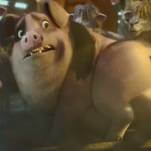
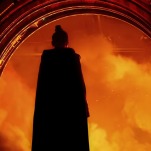

![HBO teases new Euphoria, Larry David, and much more in 2026 sizzle reel [Updated]](https://img.pastemagazine.com/wp-content/avuploads/2025/12/12100344/MixCollage-12-Dec-2025-09-56-AM-9137.jpg)


